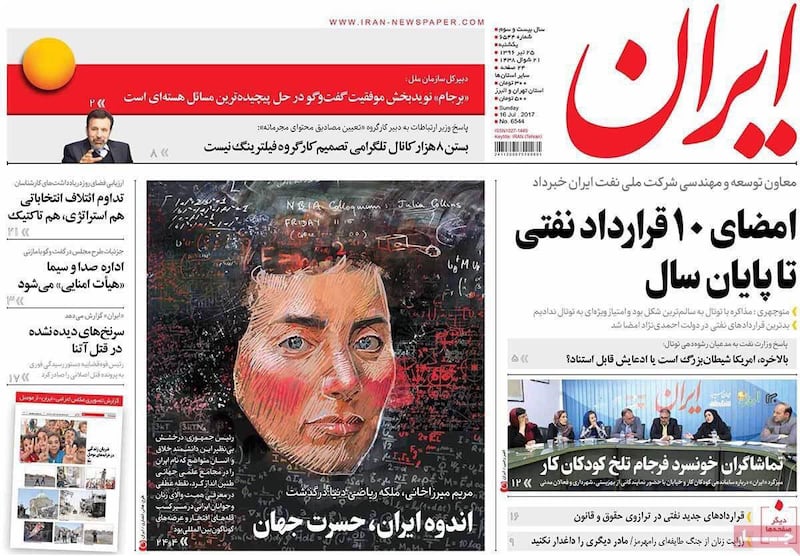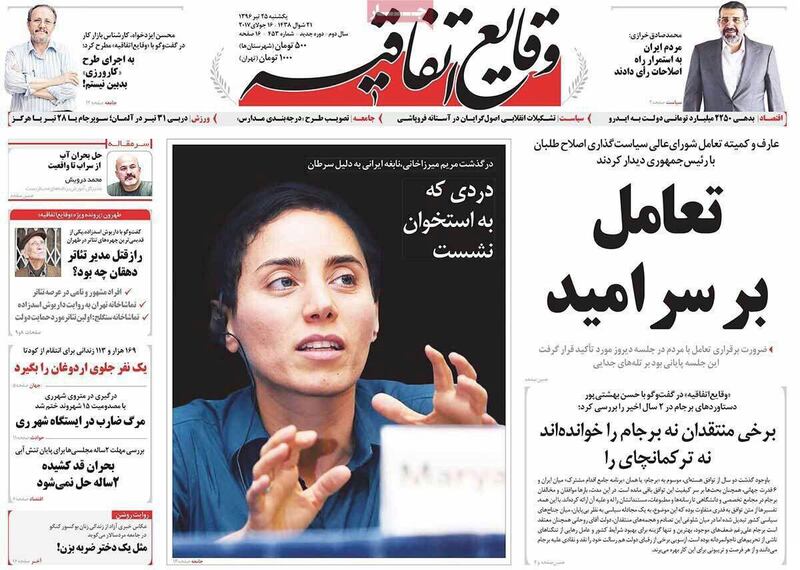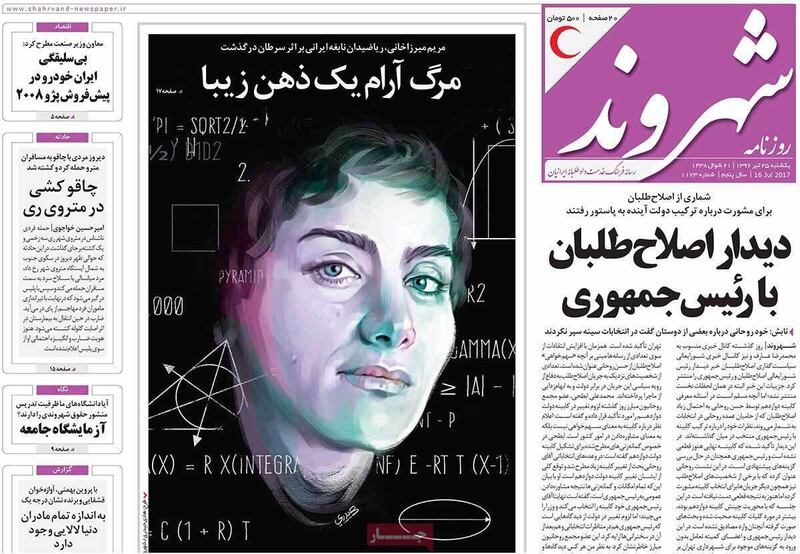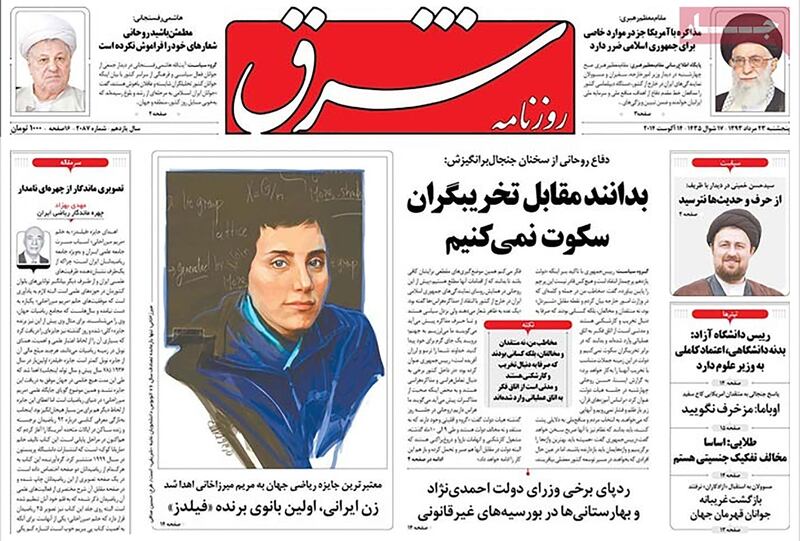News of the death of the young Iranian-American mathematics genius Maryam Mirzakhani on Saturday shocked many in Iran and around the globe.
It had only been days earlier that the world learned the 40-year-old was suffering from breast cancer. Photographs of Mirzakhani were shared everywhere, on social networks and in Iranian and foreign media, alongside celebrations of her accomplishments, including being the only Iranian and the only woman to win the prestigious Fields Medal for mathematics. For hours, her death remained one of the most trending news items in the world.
But when it came to Iran’s domestic media, a certain amount of emphasis was put on making sure Mirzakhani’s head was covered, which is mandatory under Iranian law.
ADVERTISEMENT
When Mirzakhani won the Fields Medal—often referred to as the “Nobel Prize for Mathematics”—in the summer of 2014, she got the same treatment from Iran’s media. Despite the fact that she was recognized for “her outstanding contribution” to building knowledge and understanding of the dynamics and the geometry of curved surfaces, the media chose to reduce these achievements to whether or not she was wearing hijab.
Now, they’ve done it again. Each newspaper and website found its own way of handling photographs of Mirzakhani, sometimes with a little help from PhotoShop. In one paper, her hair has been lost among the series of numbers and equations on the blackboard behind her. Other publications chose to darken the background so her hair would not stand out.
Reformist newspapers Shargh and Etemad used a drawing to forestall inevitable attacks by the official or unofficial guardians of public morality. Others cropped photos so only her face would show. Then, of course, there were those papers, like Javan and Khorasan, which somehow found photographs of the younger Mirzakhani wearing “proper” hijab.
Unexpectedly, though, there were a few papers that dared to show her as she really looked and how all recent photographs showed her—without a hijab. Hamshahri and Donya-e Eghtesad were among them. The papers may well get into trouble later, but for now, they are being rewarded for the move, with thousands of people praising them online for their defiance. And in their own defiance, Iranians and non-Iranians alike shared one photograph more than most. It’s the photograph used on the Stanford website, and seen in the Guardian and the New York Times and many other websites and newspapers: Mirzakhani’s hair is uncovered and short, and she is looking straight into the camera.

Challenge to the Official Line on Hijab
One surprising “infraction” was committed by the semi-official Fars News Agency. It tweeted the news of Mirzakhani’s death alongside a photograph of her not wearing hijab. The move led to sarcastic responses from some readers. “Hope your prayers will not be quashed,” wrote one observer called Sam. “You published a picture of her without hijab!” But others thanked Fars. “You published a picture that corresponds to the beliefs of the late Maryam Mirzakhani,” was one response.
The situation bears resemblance to what happened in 2014. There were a few newspapers and sites that dared to make the “hijab mistake.” Again, there was sarcasm: “So hijab is a relative thing?” tweeted one critic called Saeed. “When newspapers publish pictures of Maryam Mirzakhani with hijab, while websites post pictures without hijab, then it must mean that hijab is more mandatory for people who read [print] newspapers!”

The death of Mirzakhani has ignited a new round of attacks against compulsory hijab, though it’s true the debate is never long out of discussions on social media. “Forced hijab haunts Iranian women even after death,” wrote Melina. Another person was much angrier, lashing out at the website Khabar Online’s PhotoShop job and questioning how the editors could not “die of shame.” The agency had decided to cover her head even as it announced her death. “I spit on you,” the comment read.
Writer and sociologist Mohsen Hessam Mazaheri wrote that Iran’s official media had been presented with a serious challenge—“to show a popular and respectable woman without hijab.’” Unfortunately, he wrote, Iran’s official diction doesn’t really allow for this: “There is no such concept in the official-speak.” He added that the challenge of publishing a photograph of Mirzakhani provided an unexpected opportunity to challenge the official line—and in this challenge, the loser was the official discourse on hijab. The winner, he said, was Mirzakhani, the Iranian genius who, with her undeniable standing, forced at least some of the official media to accept that she had made a choice. “For the first time in almost 40 years after hijab was made compulsory,” wrote Mazaheri, “the picture of a respected Iranian woman has appeared on the front pages of the country’s newspapers.”

Yes, that’s ME Next to her!
Of course, not everyone was willing to accept this. People like the conservative Gholam-Ali Haddad-Adel, a former speaker of the parliament and the current President of the Persian Literature and Language Academy, saw no reason to change or question their position or discourse on hijab. Moreover, Haddad-Adel used the opportunity of how her death was being handled in the media to promote himself. The photo he shared online was taken when Mirzakhani lived in Iran in the mid-1990s and had been awarded a gold medal by Iran’s Mathematical Olympiad. It showed Mirzakhani in the third row with then President Hashemi Rafsanjani appearing in the front. Haddad-Adel is there, in the second row. But he decided to do his own PhotoShop job, cleanly cropping out Rafsanjani. The responses that he got, however, were far from laudatory. Those who commented talked about brain drain from Iran and asked: Why would a woman like Mirzakhani have to leave Iran to realize her potential?

The photographs of Mirzakhani across social networks were followed by another unexpected aftershock. One of the photographs posted online showed Mirzakhani holding her young daughter. According to the laws of the Islamic Republic, this little girl is not an Iranian national because her mother was married to Jan Vondrák, a non-Iranian. A few members of parliament scrambled about, trying to fix the situation. Fars News Agency published a report, again with the same picture of Mirzakhani without hijab, about parliamentarians who were busy trying to gather signatures to change the law so that Mirzakhani’s daughter may be granted Iranian nationality.
Women’s rights activists have been trying for years to persuade authorities to change the existing law, to no avail. “Cure after death,” was how one person on Twitter responded to the news story by Fars.
This story written by Aida Ghajar originally appeared on IranWire.






